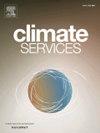Assessment of drought conditions under climate change scenarios in Central Europe (Poland) using the standardized precipitation index (SPI)
IF 4.5
3区 环境科学与生态学
Q2 ENVIRONMENTAL SCIENCES
引用次数: 0
Abstract
Human-induced climate change led to a rise in the occurrence and severity of extreme events, including droughts, on a global scale. The assessment of drought conditions is important in understanding and mitigating drought risk in the future. This study used 26 General Circulation Models (GCMs) of high-resolution NASA Earth Exchange Global Daily Downscaled Projections (NEX-GDDP) Coupled Model Intercomparison Project Phase 6 (CMIP6) datasets and the standardized precipitation index (SPI) to assess the future of droughts in Central Europe (Poland) under four Shared Socioeconomic Pathways (SSPs) scenarios (i.e., SSP1–2.6, SSP2–4.5, SSP3–7.0, and SSP5–8.5). For this purpose, precipitation in the near future (NF) (2031–2060) and far future (FF) (2071–2100) periods were projected, and then an assessment of droughts at time scales of SPI-01, SPI-06 and SPI-012 was carried out. The projection of spatial variability of precipitation in Poland revealed that it will increase slightly (10–30%) under SSP1–2.6 and SSP2–4.5 scenarios, while in the FF, it is projected to increase by 20–50% under SSP3–7.0 and SSP5–8.5 scenarios in the north/central and south of Poland, respectively. Assessment of the future of droughts demonstrated that in the NF, the frequency of droughts will decrease by approximately 20–60% in all SPI timescales (SPI-01, SPI-06, SPI-12) under all SSP scenarios. In the FF, drought frequency will increase significantly, particularly under SSP3–7.0 and SSP5–8.5 scenarios, with 50–100% increases for SPI-06 (agricultural drought) and SPI-12 (hydrological drought).
基于标准化降水指数(SPI)的中欧(波兰)气候变化情景下干旱状况评估
在全球范围内,人为引起的气候变化导致包括干旱在内的极端事件的发生和严重程度上升。干旱条件的评估对于了解和减轻未来的干旱风险非常重要。本研究利用高分辨率NASA地球交换全球每日缩减预估(NEX-GDDP)的26个大气环流模式(GCMs)耦合模式比对项目第6阶段(CMIP6)数据集和标准化降水指数(SPI),评估了4种共享社会经济路径(SSP1-2.6、SSP2-4.5、SSP3-7.0和SSP5-8.5)情景下中欧(波兰)干旱的未来。为此,对近未来(NF)(2031-2060)期和远未来(FF)(2071-2100)期的降水进行预估,并对SPI-01、SPI-06和SPI-012时间尺度的干旱进行评估。波兰降水空间变异预估结果显示,在SSP1-2.6和SSP2-4.5情景下,波兰北部/中部和南部的SSP3-7.0和SSP5-8.5情景下,波兰降水空间变异预估将略有增加(10-30%),而在FF情景下,波兰北部/中部和南部的SSP3-7.0和SSP5-8.5情景下,波兰降水空间变异预估将分别增加20-50%。对未来干旱的评估表明,在NF中,在所有SSP情景下,所有SPI时间尺度(SPI-01、SPI-06、SPI-12)的干旱频率将减少约20-60%。在FF中,干旱频率将显著增加,特别是在SSP3-7.0和SSP5-8.5情景下,SPI-06(农业干旱)和SPI-12(水文干旱)的频率将增加50-100%。
本文章由计算机程序翻译,如有差异,请以英文原文为准。
求助全文
约1分钟内获得全文
求助全文
来源期刊

Climate Services
Multiple-
CiteScore
5.30
自引率
15.60%
发文量
62
期刊介绍:
The journal Climate Services publishes research with a focus on science-based and user-specific climate information underpinning climate services, ultimately to assist society to adapt to climate change. Climate Services brings science and practice closer together. The journal addresses both researchers in the field of climate service research, and stakeholders and practitioners interested in or already applying climate services. It serves as a means of communication, dialogue and exchange between researchers and stakeholders. Climate services pioneers novel research areas that directly refer to how climate information can be applied in methodologies and tools for adaptation to climate change. It publishes best practice examples, case studies as well as theories, methods and data analysis with a clear connection to climate services. The focus of the published work is often multi-disciplinary, case-specific, tailored to specific sectors and strongly application-oriented. To offer a suitable outlet for such studies, Climate Services journal introduced a new section in the research article type. The research article contains a classical scientific part as well as a section with easily understandable practical implications for policy makers and practitioners. The journal''s focus is on the use and usability of climate information for adaptation purposes underpinning climate services.
 求助内容:
求助内容: 应助结果提醒方式:
应助结果提醒方式:


